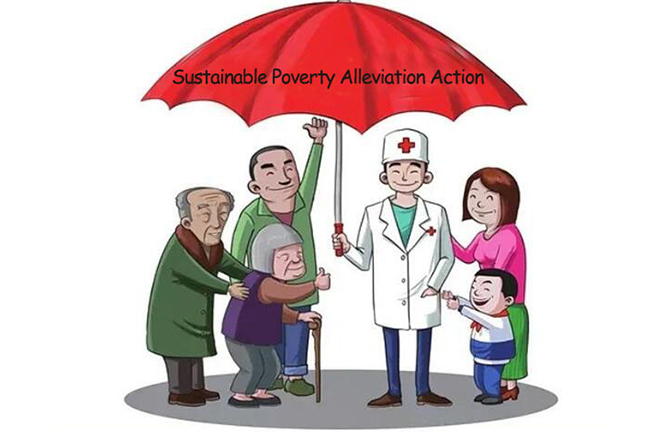Healthcare security system should transit to poverty prevention

Healthcare security is being implemented in China as an effective way to eliminate poverty. Photo: FILE
Since the beginning of the battle against poverty, China has stepped up efforts for targeted poverty alleviation through basic healthcare insurance, critical illness insurance, healthcare assistance, and other systems. This year, the battle against poverty will reach its conclusion, absolute poverty will be eliminated, but relative poverty remains. In the Fourth Plenary Session of the 19th Central Committee of CPC (Communist Party of China), it was decided to "establish a long-term mechanism to address relative poverty." Starting from 2020, the function and role of China's healthcare security system should transit from poverty alleviation to poverty prevention.
In recent years, China carried out critical work in poverty alleviation through healthcare security systems. This provides reference for future work.
First, healthcare security systems have many functions, such as income redistribution, cost control, and resource allocation. However, the most fundamental aim is to dissolve the risk of healthcare expenditures, this is the basic mission of the system. Only when activities are based on fulfilling this mission, can the system perform its other derived functions. By providing affordable healthcare to poverty-stricken populations, healthcare security work can effectively reduce the burden and risk of healthcare expenditures.
A high level of financing ability is the premise of healthcare reimbursements and benefits. Healthcare financing is not only consumption, but also human capital investment. Currently, the actual reimbursement rate among poor people in many regions reaches 90%, which can be attributed to the high totality of funds spent on the poor, which has increased significantly from previous figures. This shows that the burden of healthcare expenditures for the poor, and even for the whole population nationwide, can be effectively reduced, provided that the healthcare security system improves its financing capacity.
The system should ensure substantive fairness by offering differentiated guarantees to differentiated groups of people. Different people face different healthcare expenditure risks and have different needs. Poverty-stricken people with low incomes and a poor ability to resist risk should enjoy a higher degree of healthcare security. The system should thus be tilted towards the poor to ensure substantive fairness. This is how most countries adjust—tilting towards special groups such as the elderly, children, and low-income groups. As healthcare security systems mature, they can better offer different services to different groups of people.
However, due to the uncertainty of disease itself and unpredictable healthcare expenditures, the problems of becoming poor or re-collapsing into poverty due to illness will persist for a long time. This possibility still needs to be addressed. Different from current healthcare security work, which is mainly aimed at poor populations, future work is dedicated to poverty prevention and should be aimed at the whole population.
The first step is to improve the financing capacity of healthcare security systems. Currently, the financing abilities of employee healthcare insurance are sufficient. However, the ability of healthcare insurance to cover urban and rural residents, who account for the vast majority of the country’s population, is relatively low. Their contributions to healthcare insurance account for a low proportion of their disposable income, and the number is largely lower than their tobacco and alcohol consumption expenses and self-paid healthcare expenditures. Urban and rural residents are not entirely unable to pay, but have a low willingness to pay. This requires a shift from voluntary insurance to mandatory insurance payments. At the same time, it is necessary to appropriately increase the amount of healthcare reimbursements and benefits to reduce the risk of people's healthcare expenditures.
The next step is to strengthen points of weakness, adjusting the overall structure. One weakness is that the reimbursements and benefits guaranteed for outpatients are insufficient. Ailments treated in outpatient clinics are an important and potentially catastrophic healthcare expenditure risk, especially for the elderly poor. Therefore, it is necessary to improve reimbursements and benefits for outpatient treatment. Furthermore, critical illness insurance for urban and rural residents has abolished the upward limit (top line) for the poor, so it is suggested that healthcare insurance for employee and urban and rural residents could also do so.
The last task is to increase protection of groups who face higher risk. Poverty caused by illness is not unique to rural people, nor to low-income groups. We should focus on strengthening the healthcare assistance system for illness expenditures. For example, families whose healthcare expenditures exceed their joint income by a certain proportion can be assisted.
Wang Chaoqun is from the School of Public Administration at Central China Normal University.
Edited by BAI LE

 PRINT
PRINT CLOSE
CLOSE